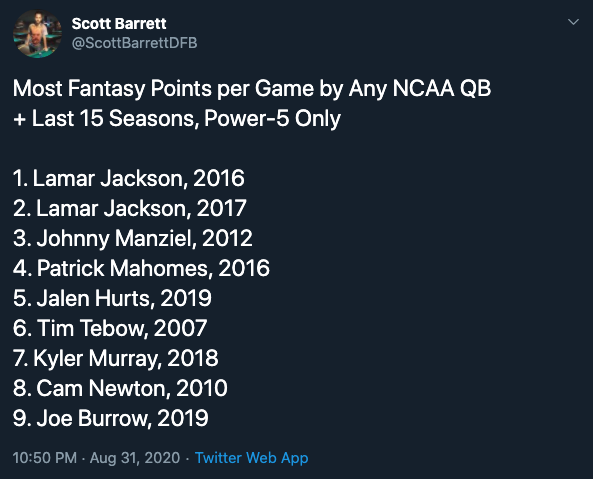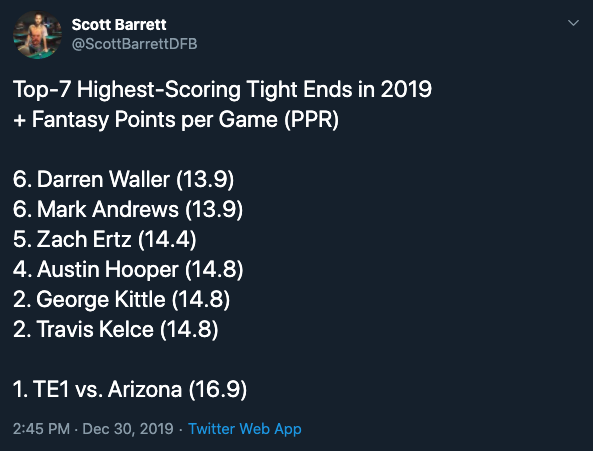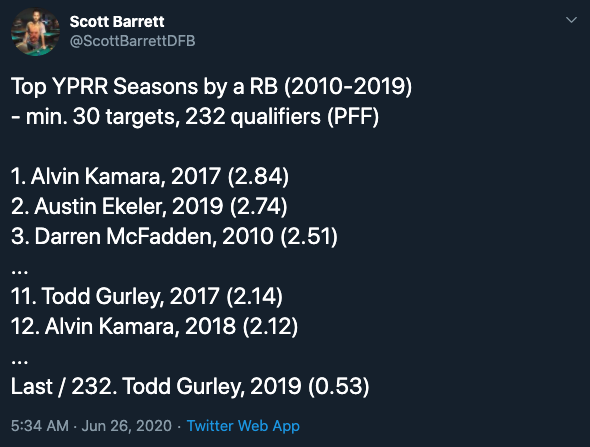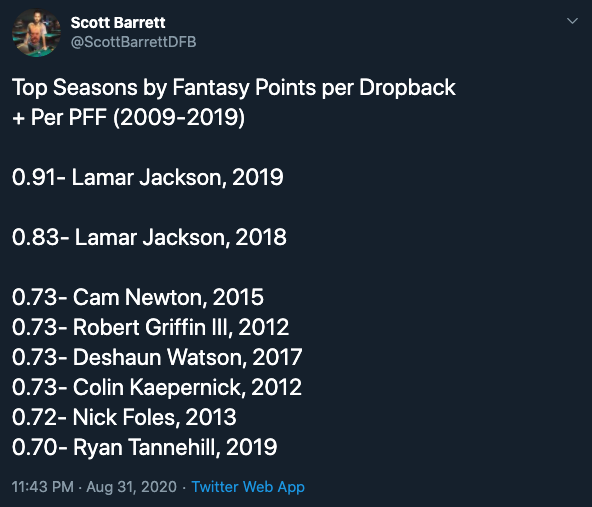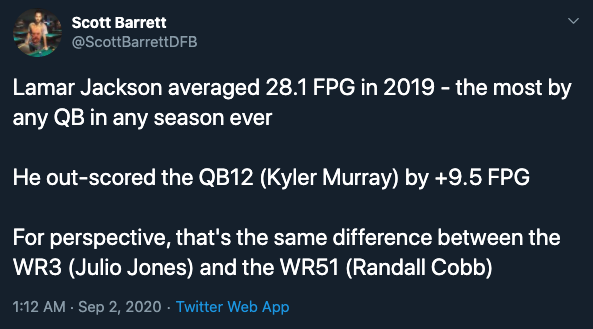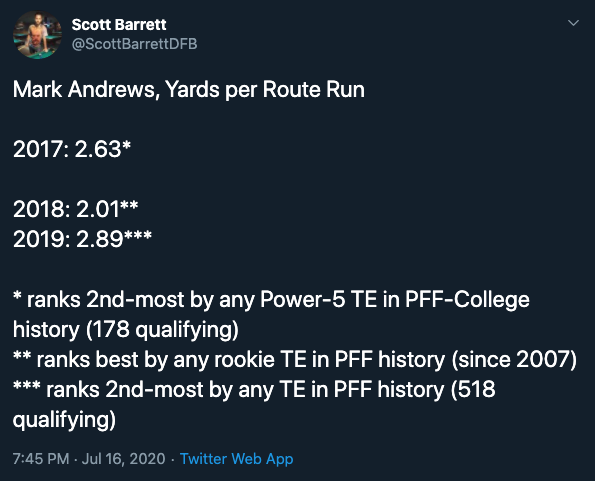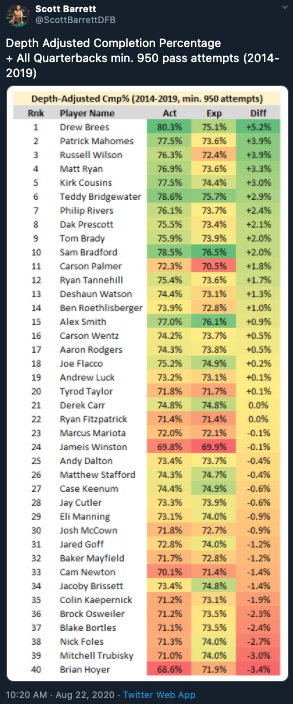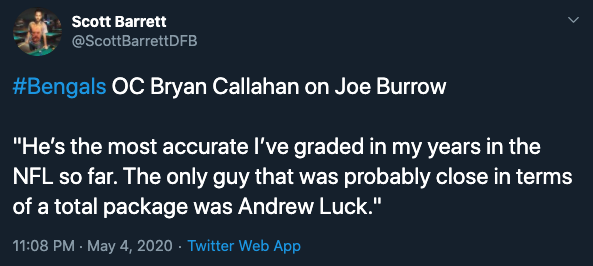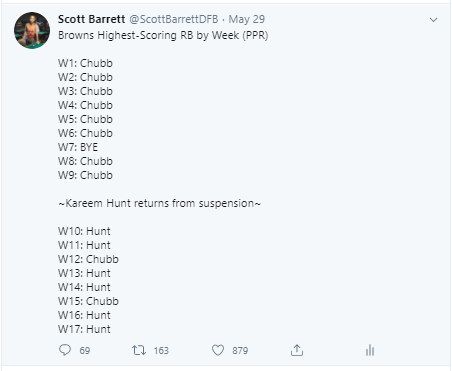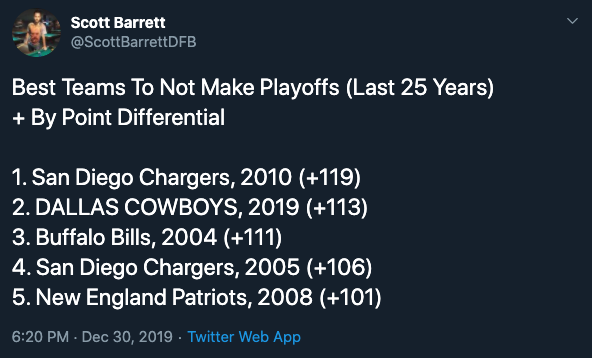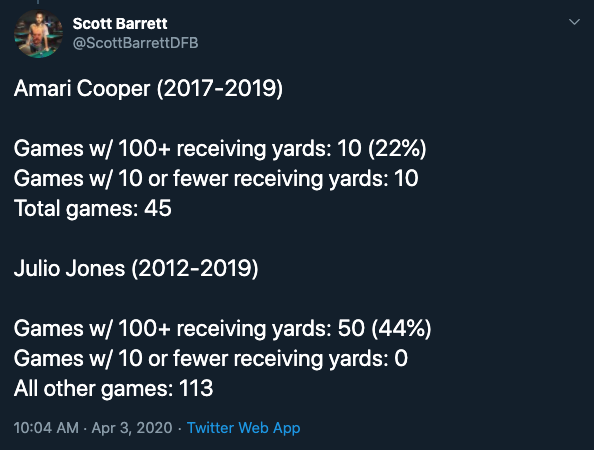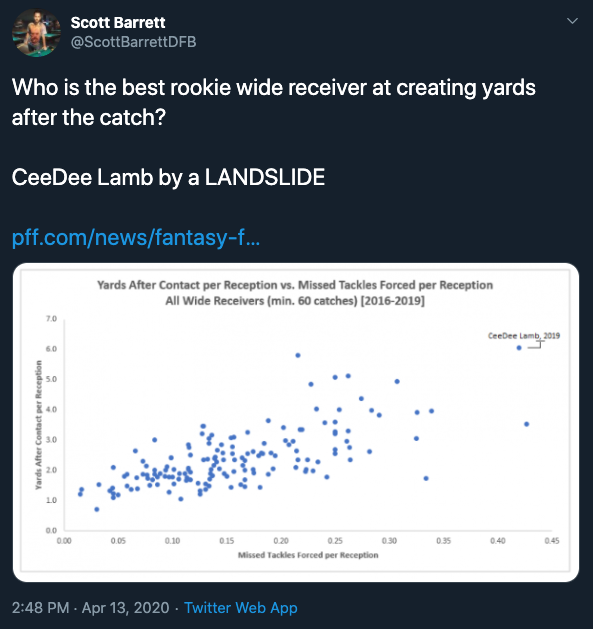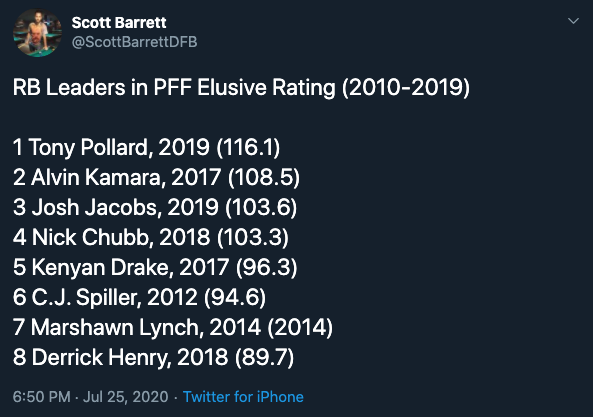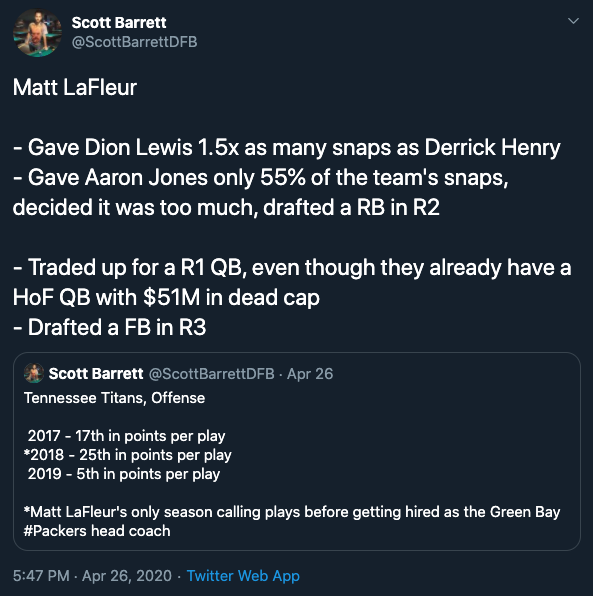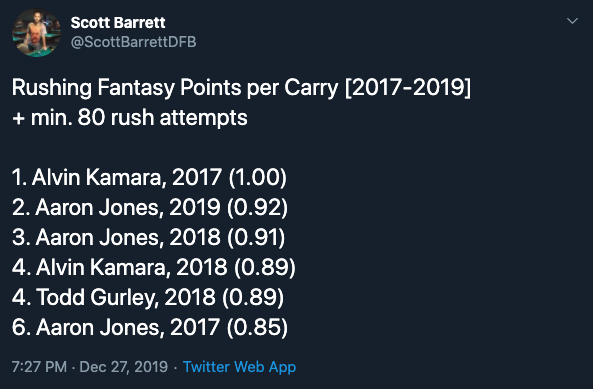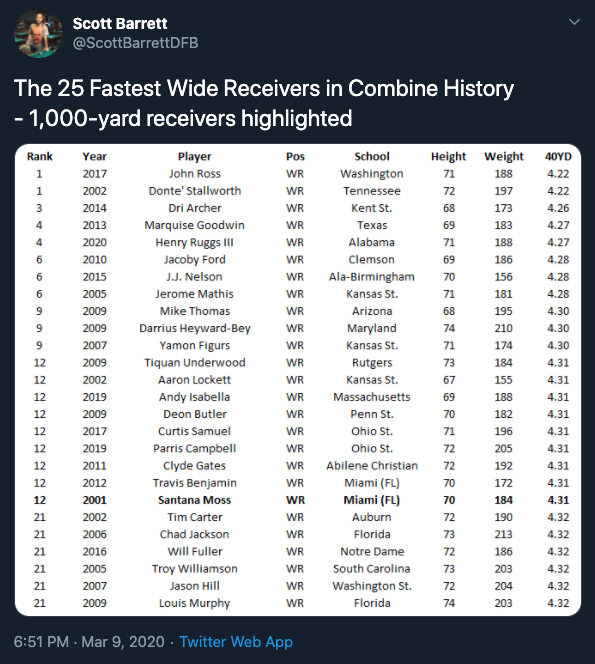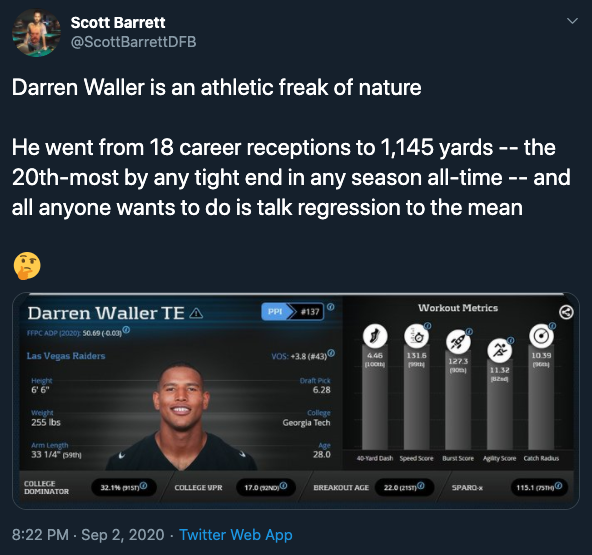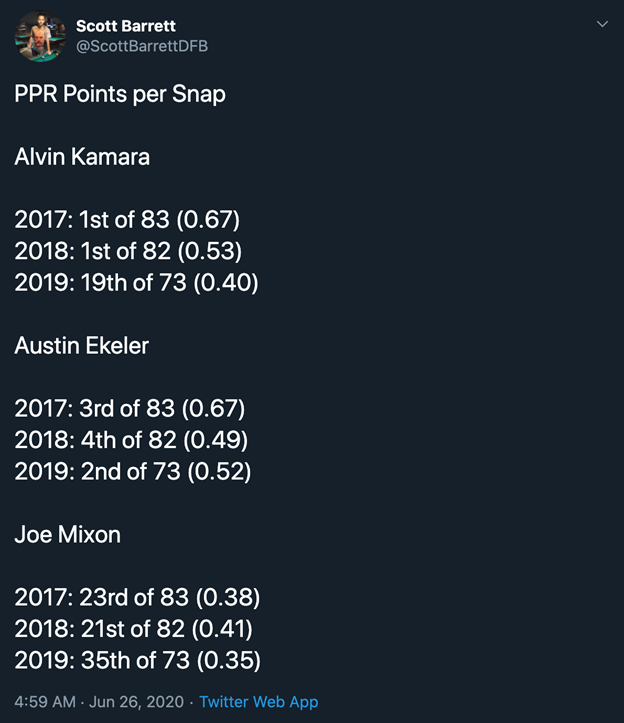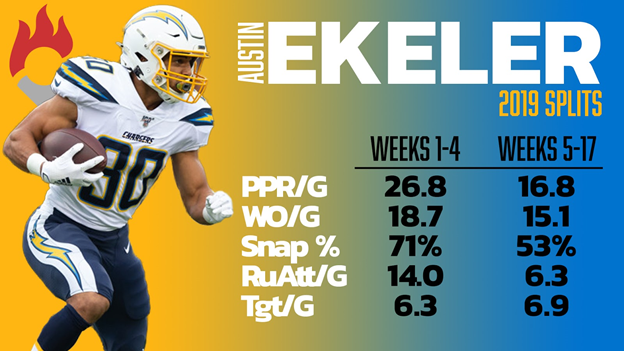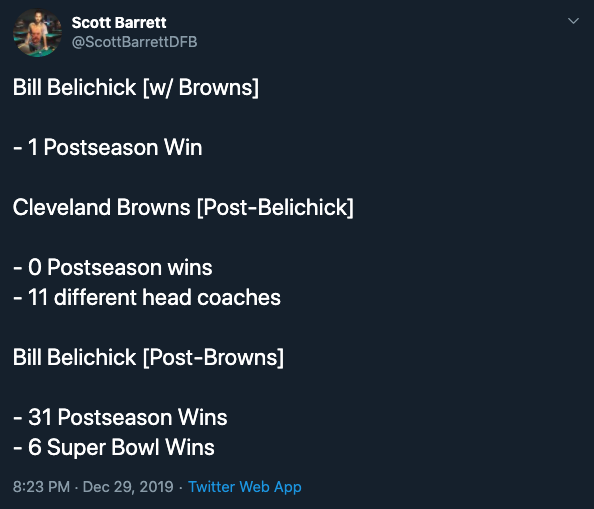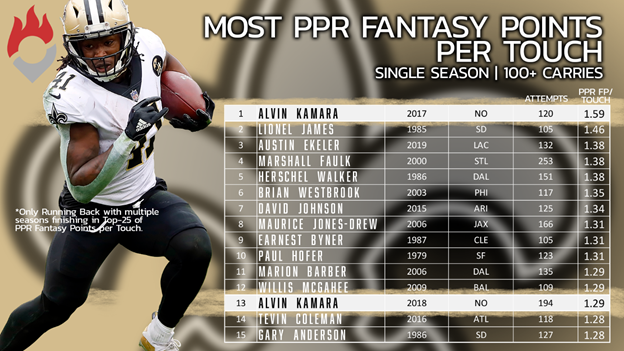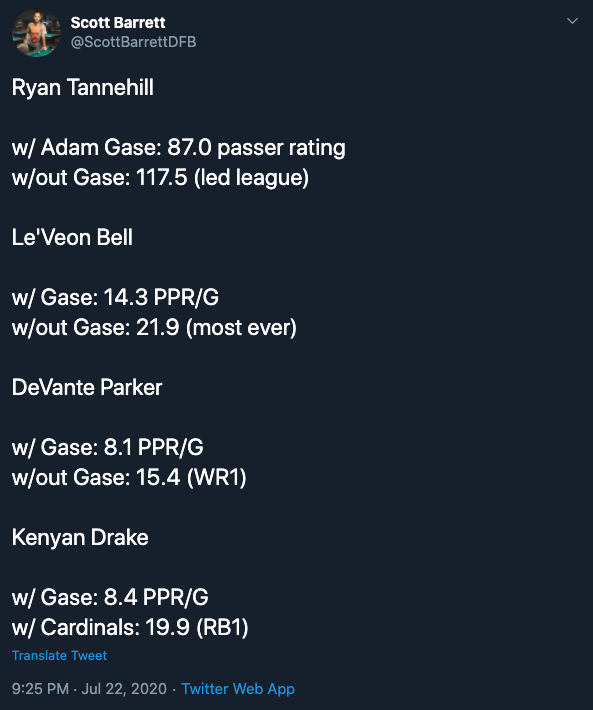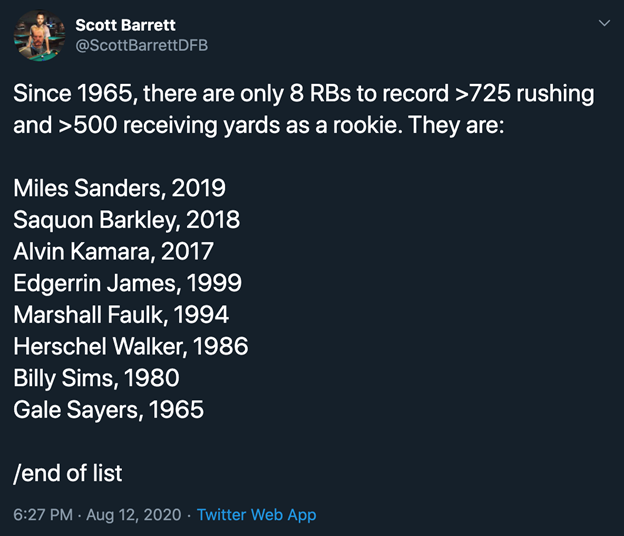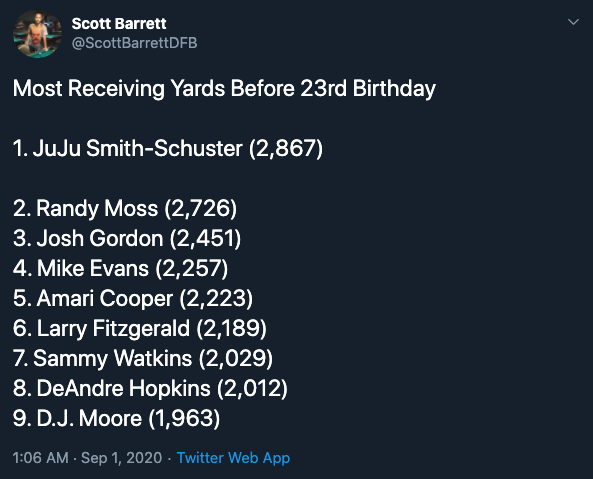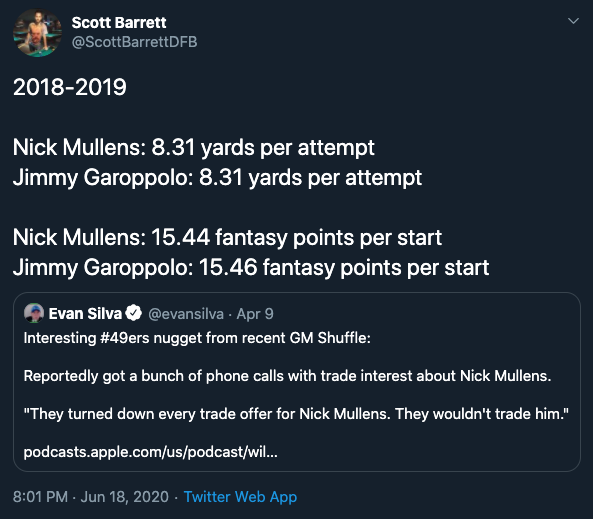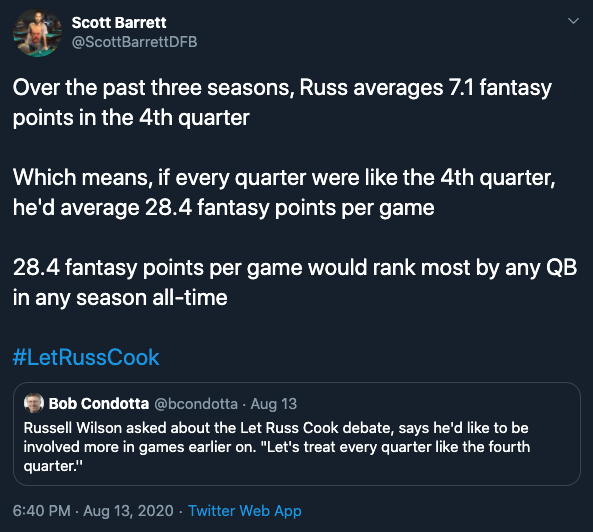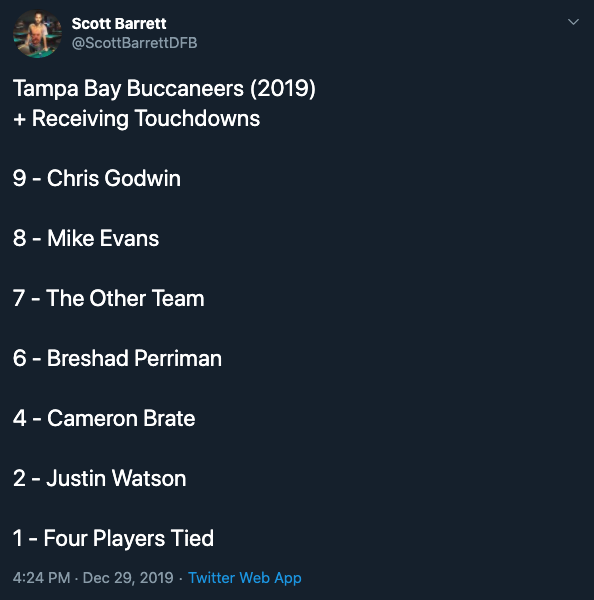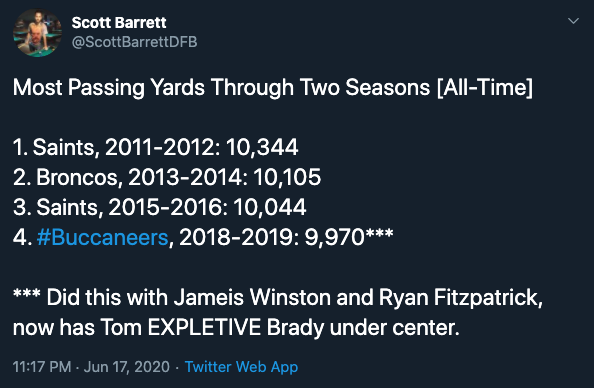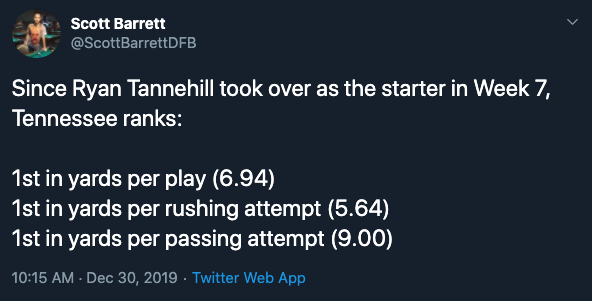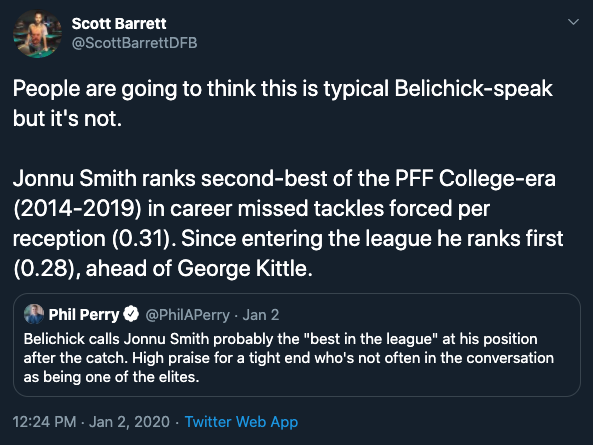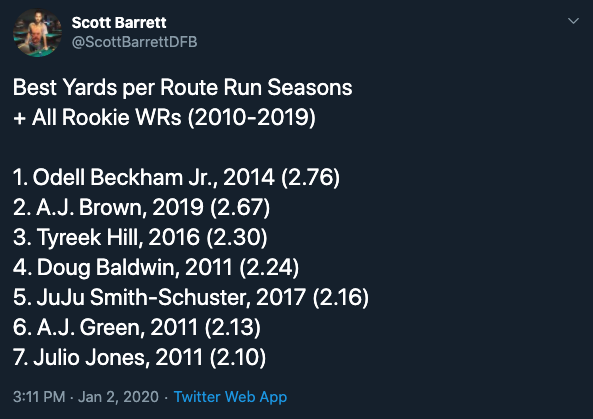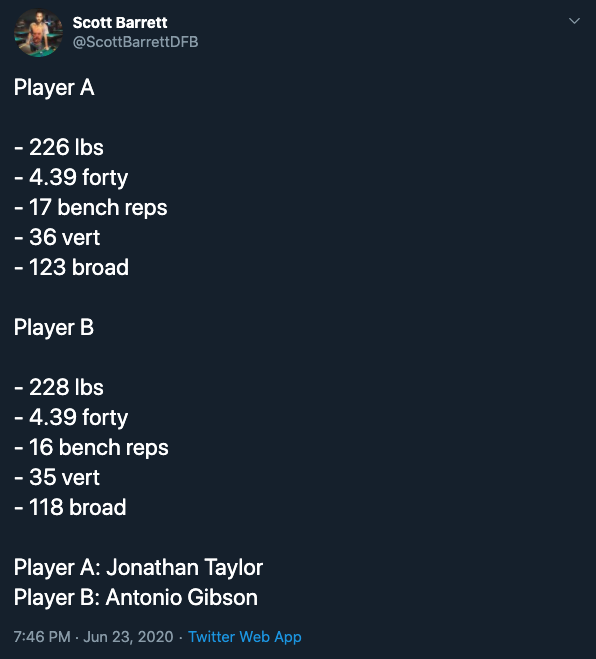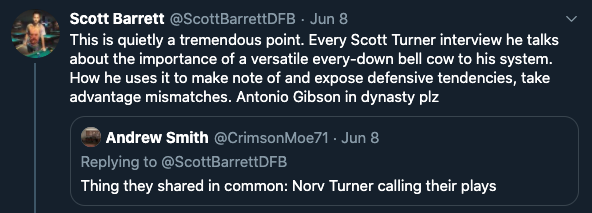You know the deal: 32 teams. 3 stats each. 96 of my absolute and unfettered dankest stats possible.
As always, shoutout to the great Matthew Berry for letting me rip him off.
REMINDER: YOU CAN UPGRADE TO STANDARD OR PREMIUM FOR 10% OFF USING PROMO CODE BARRETT10!
Arizona Cardinals
1A. In 2018, at Oklahoma, Kyler Murray averaged 36.3 fantasy points per game (FPG) – the 7th-most by any Power-5 QB since at least 2000.
1B. Johnny Manziel’s 2012 season (coached by Kliff Kingsbury) ranks 3rd-best, behind only two Lamar Jackson seasons.
1C. In 2019 Kyler Murray averaged 18.7 FPG – the 5th-most by a rookie QB in NFL history.
2A. Last year, Arizona’s RB1 (defined as the team’s highest-scoring RB in any given game) ranked 5th in FPG (20.2), behind only the Panthers, Packers, Chargers, and Vikings.
2B. From his first game in a Cardinals’ uniform until the end of the season, Kenyan Drake averaged 16.2 weighted opportunity points, 50.6 snaps, and 19.9 FPG. Those numbers would have ranked 8th-, 7th, and 3rd-best at the position last year. 2C. He ranks 11th by ADP.
3. Worried about DeAndre Hopkins going from Deshaun Watson to Kyler Murray? Don’t be. Excluding Brock Osweiler (because duh), Hopkins might be the most QB-immune WR of all time.
Atlanta Falcons
1A. Julio Jones has averaged at least 90.0 yards per game for seven straight seasons. He’s the first WR in NFL history with seven career seasons of 90.0-plus receiving yards, let alone seven such seasons in a row.
1B. But, after averaging at least 3.00 yards per route run (per PFF) in each of his previous four seasons, Jones saw that number drop to 2.44 in 2019. Might this be a sign of a 31-year-old WR in decline?
2. Per PFF, in 2019 Todd Gurley averaged just 0.53 yards per route run, which was the worst mark by any 30-plus target RB this past decade.
3A. Last season, before Mohamed Sanu was traded, Calvin Ridley averaged 53.3 yards per game. After he was traded, Ridley averaged 82.1 yards per game. For perspective, that would have been the difference between ranking 41st- and 6th-best at the position last year.
3B. Ridley averaged 22.5 FPG across the three games Austin Hooper missed last year.
3C. Ridley has seen six or more targets in 16 career games and averages 18.2 FPG in those games. For perspective, 18.2 FPG would have ranked 4th-best last season.
Baltimore Ravens
1A. In 22 career starts, Lamar Jackson averages 80.1 rushing yards per game.
1B. In 29 career starts, Saquon Barkley averages 79.7 rushing yards per game.
1C. Jackson just set the record for most FPG (27.7) by any QB in a single season ever.
1D. He led all QBs in rushing fantasy points. (Duh!) But that also would have ranked 8th among RBs.
1E. Among QBs, he ranked 4th in passing fantasy points.
1F. Basically, subtract 20 receptions, and drafting Jackson last year was almost exactly like drafting Matt Ryan and Josh Jacobs and getting both of their production in one starting spot.
2A. It is well known that a hyper-mobile QB is a cheat code for fantasy. But it’s also a cheat code for that team’s RBs (in terms of ground-game efficiency.)
2B. In 22 career starts for Lamar Jackson, Baltimore's RBs average 5.09 YPC.
2C. Gus Edwards averages 5.28 YPC on 234 carries. Mark Ingram averages 5.04 YPC on 202 carries. For perspective, Derrick Henry led all 200-plus-carry RBs last year, with 5.08 YPC.
2D. With a fairly mobile QB last year (Justin Fields rushed for over 700 yards), J.K. Dobbins became one of just 20 RBs to eclipse 2,000 rushing yards in a single season since 2000.
3A. Mark Andrews broke PFF’s YPRR record for a TE in 2019. (Though George Kittle would surpass that mark.)
3B. Of 75 qualifying WRs, Marquise Brown ranked 1st in passer rating when targeted (134.4) and 11th in fantasy points per route run (0.45).
3C. Together Andrews and Brown spent a combined 16 weeks on the injury report listed as ‘Questionable.’
3D. Andrews ranked 5th at the position in fantasy points despite playing on just 44% of the snaps in games active. TE Hayden Hurst is no longer on the team.
3E. Brown was playing on just 58% of the team’s snaps and operating at just 75-80% of his typical effectiveness last year (per himself and backed up by the medical literature). but is now back to 100%.
Buffalo Bills
1A. Since entering the league, Josh Allen averages 25.8 FPG against bottom-12 defenses (by FPG allowed).
1B. If over a full season that would rank 6th-most all-time, comparable to Peyton Manning’s famed 2013 season (26.3).
1C. Unfortunately, he has the worst overall schedule among QBs and the toughest playoff schedule at the position this year.
2A. In each of the past two seasons Buffalo has ranked bottom-3 in team fantasy points scored at the RB position.
2B. Although a hyper-mobile QB might help boost a RB’s YPC, Allen hurt Buffalo’s RBs as a run-first TD-vulture.
2C. Buffalo’s RBs total just 117 receptions over the past two seasons, which ranks above only four other teams.
2D. Over the past two seasons Allen’s 22 rushing attempts inside the 10-yard-line lead the team by a sizable margin.
3A. Last season, Stefon Diggs ranked 2nd in YPRR (2.69) and 1st in yards gained on deep passes (635).
3B. Over the past two seasons (per PFF), Josh Allen ranks worst of all 30 qualifying QBs in passer rating on deep passes (52.6). Kirk Cousins ranked 7th-best (107.4).
Carolina Panthers
1. If Christian McCaffrey’s season ended in Week 12, he still would have led all RBs in fantasy points scored.
(I could do 96 Stats on McCaffrey alone.)
2. D.J. Moore finished the 2019 season 16th in FPG (15.4). If we exclude Moore’s six-snap performance in Week 16 (concussion), he would have averaged 16.4 FPG, which would have ranked 8th-best. He ranks 12th by ADP.
3. Teddy Bridgewater has reached 21 fantasy points just three times in 44 career games.
Chicago Bears
1A. Since 2014, there have been 39 different QBs to attempt at least 1,000 pass attempts.
1B. Patrick Mahomes leads them all in adjusted net yards per attempt (8.57), followed by Drew Brees (7.53) and Tom Brady (7.32).
1C. On the opposite end of the spectrum is Brock Osweiler (5.00), Josh McCown (5.22), Blake Bortles (5.36), Colin Kaepernick (5.54), Nick Foles (5.54), and Mitchell Trubisky (5.56).
1D. In other words, three of the bottom-6 is Allen Robinson’s first QB, his most-recent QB, and his future QB. Poor guy.
2A. Last season (per PFF), David Montgomery ranked 2nd-worst of 45 qualifying RBs in yards after contact per attempt (2.33).
2B. He ranked 4th-worst of 48 qualifying RBs in yards per route run (0.77)
2C. The difference between Ezekiel Elliott and David Montgomery in terms of rushing EPA (+52.6) was greater than the difference between Russell Wilson and Matt Schaub in terms of passing EPA (+35.2).
3. What a QB competition! Nick Foles and Mitchell Trubisky are arguably the two least-accurate QBs in the NFL.
Cincinnati Bengals
1A. Tyler Boyd is one of just 11 WRs to eclipse 1,000 yards receiving in each of the past two seasons.
1B. A.J. Green has only twice fallen short of 1,000 yards. But in those injury-shortened seasons he was on pace for 1,542 and 1,233 yards.
1C. Tee Higgins averaged 3.37 YPRR at Clemson, which (per PFF) ranks top-5 among 397 qualifying Power-5 WRs since 2014.
1D. Across the six games John Ross played on over two-thirds of the team's snaps last year, he averaged 15.8 FPG.
2A. Could Joe Burrow finish as a QB1 as a rookie? Consider this:
2B. Last year's QB12 averaged 17.6 FPG. Andy Dalton hit that number in 8 of 13 games last year, finishing with an average of 16.7 (less than 1.0 off QB12).
2D. Dalton accomplished this despite getting benched, and with A.J. Green missing the full season and John Ross missing 5 of his 13 starts.
2E. Burrow has added upside as a runner, eclipsing 500 rushing yards in each of his last two seasons in college and averaging 563.0. That’s comfortably in between the numbers recorded by Konami Code favorites Daniel Jones (595.5) and Josh Allen (529.0).
3A. Through the first eight weeks of the season (before Cincinnati’s bye), Mixon ranked 41st in FPG (10.0). Throughout the remainder of the season, he ranked 7th, averaging 18.2 FPG.
3B. He jumped from 15.0 to 24.1 in touches per game and 54% to 66% in snap share. But he ranked just 36th in targets per game (2.5) over this span, with Giovani Bernard still running more routes than him.
3C. Over the past three seasons, 36 different RBs exceeded 300 receiving yards at least once.
3D. Players like Andre Ellington, Jacquizz Rodgers, Ronald Jones, and Kyle Juszczyk (twice!) all made the list.
3E. Mixon did not. 3F. I have no idea why – his 2.67 YPRR in 2016 ranks 5th-best of 357 qualifiers since 2014 (per PFF).
Cleveland Browns
1A. Odell Beckham Jr. played the entirety of last season with a sports hernia which ultimately required surgery in the offseason.
1B. Prior to last season, Beckham averaged 20.6 FPG throughout his entire career.
1C. He averaged 19.2, 18.5, 18.5, 21.3, and 24.6 FPG in his previous five seasons.
1D. Any of those numbers would have ranked top-3 at the position last year.
1E. He’s currently being drafted 13th at the position by ADP.
1F. Jarvis Landry finished 12th in total fantasy points last year, after prior finishes of 18th, 5th, 14th, and 8th.
1G. This was despite playing the entirety of the season with a fractured sacrum which ultimately required surgery in the offseason.
1H. He currently ranks 35th by ADP. 2A. Baker Mayfield is being drafted 19th at the position by ADP. 2B. He was being drafted 4th among QBs this time last year. 2C. He’s no longer being coached by Hue Jackson or Freddie Kitchens.
3A. Nick Chubb is being drafted three rounds above Kareem Hunt (Round 2 vs. Round 5).
3B. Once Hunt returned from suspension, he out-scored Chubb in six of eight games.
3C. That’s not a typo.
Dallas Cowboys
1A. #LetRussCook? How about #LetDakRun?
1B. Dak Prescott averaged just 17.3 rushing yards per game last year, behind Gardner Minshew (24.6) and Daniel Jones (21.5).
1C. He averaged 70.8 rushing yards per game in his final two seasons at Mississippi State.
2A. Excluding Amari Cooper’s three-snap performance in Week 6, he averaged 16.4 FPG.
2B. That would have ranked 8th-best at the position.
2C. He currently ranks 14th by ADP.
2D. Michael Gallup quietly ranked 6th in yards per game (79.1) last season.
2E. In the 13 games they played together last year, Gallup actually out-targeted Amari Cooper (106 to 102) while Cooper (16.0) just barely edged Gallup (15.7) in FPG.
2F. Gallup ranks just 31st by ADP.
2G. Among all 60-plus-catch Power-5 seasons since 2016 (per PFF), CeeDee Lamb’s 2019 season ranked best in yards after the catch per reception and 2nd-best in missed tackles forced per reception.
2H. According to my prospect model, Lamb is the best WR to come out in the past five years.
3. Tony Pollard just put together what was arguably the most efficient season by any RB this past decade.
Denver Broncos
1A. In 11 career seasons as an NFL head coach or offensive coordinator, Shurmur’s RB1 has averaged 17.9 carries, 4.4 targets, and 101.0 yards from scrimmage per game.
1B. That’s high-end RB1 numbers, and, keep in mind, this is just Shurmur’s average, which includes seasons from names like Trent Richardson and Peyton Hillis.
1C. Since 2016, Melvin Gordon has averaged 16.5 carries, 4.9 targets, and 99.6 yards from scrimmage per game.
2A. As a 19-year-old sophomore, Jerry Jeudy totaled 1,315 receiving yards and 14 touchdowns.
2B. Since 2000, only 9 other WRs have totaled more yards or more touchdowns at an equivalent age: Michael Crabtree, Dez Bryant, JuJu Smith-Schuster, Brandin Cooks, Marquess Wilson, Robert Woods, Keenan Allen and two players yet to declare.
2C. Attesting to the value of such a feat, Wilson is the only receiver on the list without a 1,000-yard season in the NFL.
3A. Last season Courtland Sutton finished 2nd in yardage market share (36%), 10th in PFF grade, and 12th in yards per route run (2.08).
3B. That’s in spite of bottom-7 QB play, a bottom-5 strength of schedule, and the fact that he was the focal point for opposing defenses each week.
3C. And missing from these numbers is a league-high 150 yards accrued via defensive pass interference. (He also led the league in DPIs called with eight.)
Detroit Lions
1A. Kenny Golladay is being drafted in Round 3. Marvin Jones is being drafted in Round 9.
1B. Over the last two years, Golladay has only barely outscored (15.3 to 14.1 FPG) and out-targeted Jones (154 to 153) in their 26 games played together.
1C. Jones has finished 20th, 28th, and 14th in FPG over the past three seasons.
1D. He currently ranks 40th by ADP.
2A. Rather quietly, Matthew Stafford ranked 4th in FPG (21.5) and 7th in PFF Grade (82.6) last season.
2B. He currently ranks 13th by ADP.
3. D'Andre Swift ranked behind only Jonathan Taylor in career yards per carry (6.54) and yards per route run (1.57) in the 2020 rookie RB class.
Intermission 1
Reading stat after stat can be tedious, I know, but just think of the edge you’ll have over your opponents after reading all 96 of these. In an effort to save you from stat-overload, this is your first of two scheduled intermissions.
How are you doing? Is your mind blown? Feel free to take a breather, bookmark this page, and come back later. Or, are you someone like me who just can’t ever seem to get enough fantasy stat goodness? In that case, grab a notebook, grab some popcorn, and trek on.
Green Bay Packers
1A. Last season Aaron Rodgers averaged 27.8 FPG against teams ranking bottom-6 in FPG allowed to opposing QBs. In all other games, he averaged just 14.3 FPG. 1B. For perspective, that’s either 0.4 off of Lamar Jackson for first-place or 0.1 off of Mitchell Trubisky for dead-last among all QBs.
2A. Davante Adams averages 20.5 FPG across his last 35 games, reaching at least 16.0 fantasy points in 86% of these games.
2B. Only Michael Thomas ranks higher in FPG (21.3) over this span, but is less consistent, hitting 16.0 fantasy points in only 69% of his games.
3. #FreeAaronJones
Houston Texans
1A. In 2017, before Deshaun Watson’s season-ending ACL injury, Will Fuller averaged 21.0 FPG (four games).
1B. In 2018, Fuller averaged 15.2 FPG (seven games), and that’s despite leaving two games early due to injury and spending two additional games on the injury report listed as questionable (with a hamstring injury which then plagued him for weeks).
1C. In 2019, Fuller averaged 15.9 FPG (six games), before a hamstring injury held him to just three snaps in Week 7. That injury would plague him for the remainder of the season (along with a groin injury that would limit him to just 19 snaps in Week 16).
1D. I know the injury history is brutal, but with an ADP of WR30 and DeAndre Hopkins now in Arizona, if Fuller can just stay healthy…
2A. Last season, David Johnson ranked dead last of 50 qualifying RBs in PFF’s Elusive Rating (17.4).
2B. In 2018, he ranked 50th of 56 qualifying RBs (24.8).
2C. This offseason Bill O’Brien traded DeAndre Hopkins and a Round 4 pick for David Johnson and a Round 2 pick.
2D. If this were a fantasy trade, every team in your league would suspect collusion.
3A. Since 2014, 40% of Brandin Cooks’ total receiving yards have come on deep passes, which ranks 8th-most of 80 qualifying WRs.
3B. That’s a high number, but somehow less than Kenny Stills who ranks 2nd (48%) and just slightly more than Fuller who ranks 10th (39%).
3C. Last year Deshaun Watson led the league in deep accuracy percentage (37.5) per PFF.
Indianapolis Colts
1. Jonathan Taylor averaged 2,193.7 yards from scrimmage per season in college. That’s the most by any Power-5 RB since at least 1956.
2A. Across six seasons as NFL offensive coordinator or head coach, Frank Reich’s TE1 has averaged at least 13.0 FPG five times.
2B. That’s typically enough to rank top-5 or top-6 at the position in FPG.
2C. Last year was the first year Reich’s TE1 failed to average at least 13.0 FPG. Even so, Jack Doyle still led the team in targets.
2D. He’ll miss the start of the season with an injury, but Trey Burton is worth adding to your waiver wire watch list.
3A. T.Y. Hilton currently ranks 28th by ADP.
3B. Before calf and quad injuries derailed his season, Hilton averaged 18.1 FPG through his first five games (5th-most).
3C. After the hot start to the season, he’d play just four games and on just 54% of the snaps in those games.
3D. Before last year, Hilton had finished 13th, 38th, 7th, 30th, and 11th in FPG.
3E. Or, excluding seasons in which Andrew Luck missed over half the year, 13th, 7th, and 11th.
Jacksonville Jaguars
1A. Last season Gardner Minshew averaged 16.8 FPG, which was the 9th-most by any rookie QB ever.
1B. He ranked tied with Deshaun Watson for 4th in rushing yards per start (27.5).
1C. If excluding 2014 and 2018 due to injury, and 2019 because he was fired halfway through the season…
1D. Jay Gruden’s QB1 has ranked 5th, 5th, 8th, 4th, and 12th in total fantasy points since 2012. 1E. He ranks 22nd by ADP. 1F. (If you’re a subscriber, you really need to watch our most recent livestream and hear Greg Cosell’s thoughts on Minshew.)
2. DJ Chark picked up a bad ankle sprain late in the season, keeping him off the field in Week 15, and then sapping him of his typical effectiveness in Weeks 16 and 17. Before that, however, he ranked 8th in FPG (16.5). He now ranks just 21st by ADP.
3. In 2018, Laviska Shenault comprised a whopping 49.7% of his team’s passing yards in games active. That’s the best mark by any Power-5 WR since Demaryius Thomas (2009).
Kansas City Chiefs
1A. Over the past four seasons, Travis Kelce has finished 1st, 1st, 1st, and 1st among TEs in fantasy points.
1B. Among all WRs, he would have ranked top-10 in fantasy points in each of the last three seasons.
1C. This year he’s being drafted 1st among TEs and 7th among WRs.
2. What regression? Excluding the two games in which he suffered an in-game injury (Week 7 and Week 14) and including the playoffs, Patrick Mahomes averaged 24.6 FPG across 15 games. For perspective, 24.6 FPG would rank 9th-most by any QB in any season all-time. His 2018 season ranks 3rd-most all-time (26.8).
3A. In Week 1, Tyreek Hill played just 13 snaps before suffering a clavicle injury which knocked him out of the game and kept him off the field for the next four weeks. In Week 11, Hill spent all but seven snaps on the bench, after suffering a minor hamstring injury.
3B. Excluding those two games, where he played less than a full quarter before suffering an injury, Hill would have jumped from 10th (15.7) to 3rd in FPG (18.4).
(The Clyde Edwards-Helaire stats are too dank not to paywall.)
Las Vegas Raiders
1A. Last season (per PFF) Josh Jacobs led all RBs in missed tackles forced per touch (0.30) and Elusive Rating (103.6).
1B. Not only did he lead the league, but these were historically great marks – ranking, respectively, 3rd- and 2nd-best by any RB this past decade.
1C. Keep in mind, he did this while playing through a fractured shoulder for over half of his season.
2A. Among all WRs (since at least 2000) to run the 40-yard-dash at the Combine, Henry Ruggs’ time of 4.27 ranks 4th-fastest.
2B. Of the 25 fastest WRs, only one has ever reached 1,000 yards receiving in a single season (Santana Moss).
2C. The NFL mistakenly did not deem Jerry Jeudy or CeeDee Lamb as deserving of a top-15 pick and the Raiders thought Ruggs was the best WR in his class.
2D. Hot Taek: He wasn’t the best WR on his own team. And he wasn’t 2nd-best either.
3A. Bryan Edwards and JuJu Smith-Schuster are the only Power-5 WRs this past decade to record a 100-yard game as a 17-year-old.
3B. At South Carolina in 2018, future No. 36 overall pick Deebo Samuel averaged just 6.1 more yards per game than Bryan Edwards in games they were both active (73.4 to 67.4).
3C. Keep in mind, Edwards is three years younger than Samuel, who was 23 when he was drafted by the 49ers.
Los Angeles Chargers
1. Hunter Henry is arguably the league’s most efficient player on a per target-basis. Since entering the league, he leads all players at all positions in passer rating when targeted (133.0) and first downs per target (0.54).
2A. Across Tyrod Taylor’s last two seasons as a starter, his three highest-scoring receivers were: Sammy Watkins in 2016 (10.4 FPG), Robert Woods in 2016 (9.2 FPG), and Charles Clay in 2017 (9.1 FPG).
2B. For perspective, 10.4 FPG would have ranked outside of the top-50 WRs last year.
3A. Over the past two seasons, Austin Ekeler ranks 3rd in PFF grade (90.4), behind only Nick Chubb and Christian McCaffrey.
3B. He’s ranked top-5 in fantasy points per snap in every year of his career.
3C. In Weeks 1-4, without Melvin Gordon, Ekeler was used as a true bell cow, playing on 71% of the snaps and averaging a whopping 26.8 FPG, which ranked behind only McCaffrey.
3D. Once Gordon returned, Ekeler was stuck in a full-blown committee, playing on only 53% of the snaps. Even so, he still ranked 5th in fantasy points over this span, averaging 16.8 FPG. 3E. With Gordon now in Denver, will Ekeler return to that late-season committee role (with Justin Jackson and/or Joshua Kelley serving in Gordon’s old role) or might he be the league-winning bell cow he was to start the year? TBD.
Los Angeles Rams
1A. Prior to last season, Sean McVay was widely heralded as one of the greatest offensive minds in football.
1B. Jared Goff is now being drafted 19th among QBs, despite leading the league in pass attempts last year.
1C. Across the two seasons previous, he ranked behind only Patrick Mahomes (8.72) and Drew Brees (8.07) in ANY/A (7.70).
1D. Over the last three seasons, Goff has ranked 13th, 6th, and 13th in total fantasy points.
2A. Cooper Kupp was the PPR WR3 across Weeks 1-8.
2B. And then Robert Woods out-targeted Kupp 80 to 47 from Weeks 9-17 last year.
2C. From Week 9 on, Woods ranked 2nd in FPG (19.2) and 4th in targets per game (11.3).
2D. From Week 13 until the end of the regular season Tyler Higbee led all players in receiving yards, ending the season by scoring 23.7, 18.6, 23.1, 19.4, and 22.4 fantasy points.
2E. This all came immediately after Gerald Everett hyperextended his knee in Week 12. Prior to that point, Everett had actually out-targeted Higbee in nine straight games (56 to 22).
2F. What changed?
2G. Through the first 12 weeks of the 2019 season, Los Angeles played out of 11 personnel 76% of the time (2nd-most). They played out of 12 personnel (2TE) just 17% of the time.
2H. From Week 13 on, only one team played out of 12 personnel more often than Los Angeles’ 40%.
2I. The Rams have promised to continue that trend in 2020.
3A. Over the past three seasons, Todd Gurley has averaged 252.7 carries, 72.3 targets, 1,662.7 total yards, and 18.0 total touchdowns per season.
3B. That’s 324.9 fantasy points per season and 22.2 FPG.
3C. Historically speaking, if Cam Akers (ADP: RB26) is just 80% of that (17.8 FPG) he’s a likely top-6 fantasy RB. If he’s just 66% of that (14.7 FPG), he’s still likely a borderline RB1.
Miami Dolphins
1. Over the past two seasons Ryan Fitzpatrick averages more fantasy points per start (20.09) than Dak Prescott (20.08), Russell Wilson (20.0), and Josh Allen (19.0).
2A. Jordan Howard picked up a shoulder injury in Week 9 that left him without a single touch from Week 10 until the end of the season.
2B. Across the seven weeks leading up to that point, Howard ranked 4th in rushing fantasy points despite ranking just 12th in rushing attempts.
2C. Miami made him the 11th-highest-paid RB of the 2020 season and he ranks just 40th by ADP.
3A. Over the final 14 weeks of last season, DeVante Parker ranked 5th among all WRs in FPG (17.5).
3B. From Week 9 until the end of the season, Mike Gesicki ranked 4th among TEs in targets (64) and 8th in fantasy points.
3C. Of course, before Preston Williams’ season-ending injury in Week 9, the rookie led all of Miami’s receivers in targets, receptions, and yards.
3D. ESPN’s Mel Kiper called Williams a “sleeper first round” prospect before ultimately going undrafted due to off the field concerns. But Williams’ collegiate profile is that of a borderline first round talent.
3E. Before being drafted 81st-overall by the Cowboys, Michael Gallup posted a 100-1418-7 line at Colorado State as a Senior.
3B. The following season at Colorado State (after sitting out a full year) Preston Williams posted a similarly dominant line. He turned 96 catches into 1,345 yards and 14 touchdowns. That was nearly double the yardage accrued by teammate and fellow future NFL WR Olabisi Johnson (54-796-4).
3C. He’s being drafted as the WR52 on average, six rounds and 24 spots below Parker.
Minnesota Vikings
1A. In 12 seasons as an offensive coordinator, Gary Kubiak’s offense has ranked top-12 in rushing yards 12 times. And top-5 nine times. (That’s pretty insane.)
1B. In 12 seasons as an offensive coordinator, Kubiak’s TE1 has finished top-5 in FPG eight times.
1C. In 22 seasons as an NFL head coach or offensive coordinator, his TE1 has earned a target share of 17% or higher in 14 seasons. Only five TEs earned a target share over 17% last year. They all finished top-6 in FPG.
2. Prior to Adam Thielen's (ADP: WR18) Week 7 injury, he had reached at least 12.5 fantasy points in 19 of 22 games, with an average of 18.5 FPG over this span. For perspective, 18.5 FPG would have ranked 3rd-best at the position last year.
3A. First round rookie WR Justin Jefferson ran 99% of his routes from the slot in 2019.
3B. This was arguably the worst landing spot for a slot WR, as no team had a slot WR on the field running a route less often than Minnesota last year.
3C. Their 288 slot WR routes was nearly half the team that ranked second from last.
New England Patriots
1A. Cam Newton averaged a meager 8.4 FPG over his last four starts.
1B. However, across the 25 starts before that, he averaged 22.3 FPG. For perspective, only Lamar Jackson averaged over 22.3 FPG last season.
1C. Prior to 2019, Newton had finished top-5 in FPG in five of eight seasons and top-7 in seven of eight seasons.
1D. He currently ranks 14th by ADP.
2A. Last season Julian Edelman spent a whopping 13 of 16 games on the injury report listed as questionable, with chest, shoulder, and knee injuries.
2B. He played with partially torn rib cartilage from Week 3 on, a separated AC joint in his shoulder from Week 11 on, and knee tendinitis from Week 14 on.
2C. The shoulder injury, which ultimately required surgery after the season, was the worst of the three. Before that injury, Edelman ranked 3rd among all receivers in receptions (63).
2D. In spite of all of this, he still finished 11th in FPG (15.7).
2E. He can overcome extreme injury, but will he be the same fantasy asset without Tom Brady? 2F. Newton has only twice ever supported a WR ranking top-25 in FPG.
3. The last time the Cleveland Browns won a playoff game, Bill Belichick was their head coach. Bill Belichick has since won 31 more playoff games, including six in the Super Bowl.
Intermission 2
Still with me? We're more than two-thirds of the way done — only 10 teams or 30 stats to go. Now might be a good time to remind you to subscribe to FantasyPoints — to get more great stats like this every week — and to follow me on twitter.
New Orleans Saints
1. How special was Michael Thomas’ 2019 season? His 366.9 fantasy points during fantasy weeks (Weeks 1-16) is the 3rd-most by any WR in any season all-time. Only Marvin Harrison’s 2002 season and Jerry Rice’s 1995 season rank ahead.
2. Drew Brees (ADP: QB8) averaged 22.8 FPG in 2019 if we exclude Week 2 (where he played just five snaps before suffering an injury). For perspective, 22.8 FPG would have ranked behind only Lamar Jackson.
3A. Without exaggeration, Alvin Kamara is arguably the most efficient fantasy RB of all-time.
3B. Since the NFL merger (in 1970), there have been 2,255 instances of a RB drawing at least 100 carries in a single season.
3C. Of those, Kamara’s 2017 season ranks 1st in fantasy points per touch (1.59). His 2018 season ranks 13th (1.29) – making him the only RB with multiple seasons in the top-25.
3D. His 2019 season, however, ranked just 218th (0.99). What happened?
3E. He was hurt, playing at just 75% and “on only one leg”, after tearing a ligament in his knee in Week 6.
3F. Though he spent just three weeks on the injury report, it was obvious to anyone paying attention that he was playing hurt. Through the first five weeks of the season (before his injury), Kamara led all 38 qualifying RBs in PFF’s Elusive Rating. Throughout the remainder of the season, he ranked just 34th of 40 RBs.
New York Giants
1A. George Kittle has averaged 13.1 FPG since entering the league in 2017. Over the same span, Evan Engram averaged 13.5 in his 23 games without Odell Beckham Jr.
1B. Jason Garrett hasn't called plays since 2011.
1C. But when did call plays, the offense ran through the TE. Jason Witten ranked 1st, 3rd, 6th, 2nd, and 7th in FPG. He averaged 126.2 targets, 88.8 receptions, 1,014.2 yards, and 5.2 touchdowns per season.
2A. From Week 8 until the end of the season, Daniel Jones ranked 5th among all QBs in FPG (21.2).
2B. He eclipsed 32.0 DK fantasy points in four of his 12 starts last year.
2C. For perspective, only six other times in the history of football – Lamar Jackson (2019), Deshaun Watson (2017), Peyton Manning (2013), Drew Brees (2012), Mike Vick (2010), Daunte Culpepper (2004) – has a QB eclipsed 32.0 DKFP in at least 33% of his starts.
3A. Is Sterling Shepard a “buy” or a “fade”? It depends. Will he be playing on the outside, or will the Giants move him back to the slot? 3B. Last season, Sterling Shepard averaged 1.89 yards per route run from the slot but only 1.11 when split out wide (11th-worst of 63 qualifiers).
3C. When Golden Tate was inactive last year, Shepard lined up in the slot 80% of the time. When Tate was active, Shepard's slot rate dropped to 32%.
3D. Shepard averaged 16.8 FPG when running over two-thirds of his routes from the slot, and only 10.9 FPG when running under a third of his routes from the slot.
New York Jets
1A. As a rookie, in 2018, Chris Herndon finished 8th in YPRR and 6th in PFF grade while totaling 502 yards on only 56 targets.
1B. This made him one of just 16 rookie TEs to eclipse 500 receiving yards over the past 30 seasons, or one of just five over the past six seasons (joining George Kittle, Mark Andrews, Evan Engram, and Noah Fant).
1C. And, from Week 6 until the end of the season, Herndon ranked 6th in (standard) fantasy points, despite ranking just 15th in targets over this span.
1D. He currently ranks 20th in ADP, after ranking 13th early last year (before his suspension was announced).
2A. Le’Veon Bell will be the league’s highest-paid RB in 2020, with a cap hit over $4 million more than the next-closest runner.
2B. Based on training camp reps, New York beat reporters are projecting a 60/40 split between Bell and Frank Gore this season.
2C. Frank Gore is 37 years old, fresh off of a 3.61 YPC season where he converted just two of 25 red zone opportunities into touchdowns.
2D. Sam Darnold was 7 years old when Frank Gore was drafted by the 49ers.
2E. Only 43% of American children learn to tie their shoes before they’re 7 years old.
2F. Adam Gase also tried to trade a draft pick for Kalen Ballage. (He failed his physical.)
2G. Ballage averages 3.0 YPC on 110 career carries. And averages a drop every 7 targets on 35 career targets.
3A. Over the past four seasons, Adam Gase’s offenses have ranked 32nd, 31st, 25th, 24th in yards per game.
3B. By point differential, his teams have ranked 31st, 30th, 29th, and 24th.
3C. Since January 1st, the U.S. Department of Labor estimates that 36 million Americans have lost their jobs.
3D. Somehow, Adam Gase was not one of them.
Philadelphia Eagles
1. From Weeks 11-16, Miles Sanders ranked 5th in snaps per game (58.6), 6th in weighted opportunity points per game (17.9), and 7th in FPG (18.8)
2. In 2019, Carson Wentz became the first QB in NFL history to throw for 4,000 yards without a single WR reaching 500 yards receiving.
3A. What was the difference between Philadelphia’s first round draft pick Jalen Reagor and college football’s top wideout? QB play.
3B. Over the last two seasons, with an average depth of target (aDOT) of 13.6, Ja’Marr Chase was deemed open on 69% of his targets. 65% of those throws were charted as accurate. (Per PFF.)
3C. Over the past two seasons, with an identical aDOT of 13.6 (implying same difficulty of throws), Reagor was charted as open on 73% of his targets. But only 37% of those throws were deemed accurate.
Pittsburgh Steelers
1. Prior to last season, Ben Roethlisberger ranked 3rd, 8th, 7th, 7th, and 6th in FPG. He currently ranks 17th by ADP.
2. JuJu Smith-Schuster holds the record for most receiving yards by any player before turning 23 years old (2,867), just ahead of Randy Moss (2,726).
3A. In 2018, James Conner spent the final four weeks of the season on the injury report with an ankle sprain, sitting out for the entirety of your fantasy postseason.
3B. Prior to that, Conner was averaging 19.0 weighted opportunity points- and 22.3 FPG. For perspective, both numbers would have ranked top-6 among RBs.
3C. In 2019, Conner suffered a knee injury in Week 2, a quadricep injury in Week 6, and then a shoulder injury in Week 8. He would then spend seven of the team’s final nine games on the injury report, missing six of those games.
3D. Prior to that, Conner was averaging 15.9 weighted opportunity points- and 17.8 FPG. For perspective, both numbers would have ranked top-8 among RBs.
3E. Conner ranks just 17th by ADP.
(The Diontae Johnson stats are too dank not to paywall.)
San Francisco 49ers
1A. In 2018, George Kittle set a PFF-era record for yards per route run by a TE (2.82).
1B. In 2019, he shattered that record, averaging 3.11. This led all players at all positions and ranked 2nd-best of the past decade, just barely behind only Julio Jones’ 2016 (3.12).
1C. He also led the position in drop rate, dropping only one of his 106 targets.
1D. Keep in mind, Kittle accomplished all of this with a torn labrum and a broken bone in his ankle.
1E. Over the past two seasons, Kittle leads all receivers in yards after the catch, yards after contact, and missed tackles forced (per PFF).
1F. He’s also ranked top-5 in PFF run blocking grade in each of the past two seasons.
1G. He led all TEs in overall PFF grade in 2018.
1H. In 2019, he led all players in PFF grade (95.0).
1I. He was the most efficient receiver in football last year, and he blocks like a left tackle. In my opinion, he’s the most valuable non-QB in football.
2. Raheem Mostert is technically the most efficient RB of all time, averaging 6.01 YPC for his career.
3A. Over the past two seasons, George Kittle leads all receivers in yards after the catch (1,494), and the next-closest receiver (Michael Thomas) isn’t even really close (1,091).
3B. Deebo Samuel averaged 8.49 yards after the catch per reception in 2019, which was the 5th-best mark by any 50-catch receiver this past decade.
3C. Round 1 rookie WR Brandon Aiyuk led the 2020 draft class in career yards after the catch per reception (9.9).
3D. Notice a trend here? No excuses for Jimmy Garoppolo in 2020 – he should be able to average 7.8 YPA on a 2.7 aDOT.
Seattle Seahawks
1A. From Weeks 1-9, Tyler Lockett ranked 3rd among all WRs in fantasy points, averaging 19.0 FPG.
1B. In his next game, he suffered a “severe” lower leg contusion and was forced to spend the night in the hospital. It’s hard to guess at how long this injury might have plagued him, but his numbers certainly suffered until Week 15.
1C. From that point on, and including the postseason (five games total), he averaged 16.8 FPG.
1D. Across those 14 games he averaged 18.2 FPG, or what would have ranked 4th-most last year. 1E. He ranks just 21st by ADP.
2. In his career, Will Dissly averages 15.0 FPG in games started and finished. For perspective, only Travis Kelce and George Kittle averaged more than 15.0 FPG last year.
3A. #LetRussCook? #LetRussCook!
3B. Through 8 NFL seasons, Russell Wilson has finished top-4 in fantasy points per dropback 6 times.
3C. To illustrate how utterly absurd that is, the next-closest QB (Cam Newton) had only three such finishes over this span, and he was one of only three other QBs to finish top-4 more than once.
3D. However, over this span, Seattle ranked bottom-12 in dropbacks per game in all but two seasons, with four bottom-4 finishes over this span.
3E. If Seattle had ranked just league average in dropbacks per game in each of these seasons, Wilson would have exceeded 22.75 FPG five times.
3G. For perspective, 22.75 FPG would have been enough to finish 2nd-best at the position last year.
Tampa Bay Buccaneers
1A. Prior to last season, Tom Brady had finished 5th, 1st, 1st, and 2nd in PFF grade.
1B. Through the first nine weeks of the 2019 season, Brady ranked 6th in PFF grade, while averaging 18.8 FPG (10th-most) and 7.1 yards per attempt.
1C. Throughout the remainder of the season, Brady ranked just 18th in PFF grade, while averaging just 14.7 FPG and 5.9 yards per attempt (worst).
1D. What changed? Was this second-half dropoff yet another obvious sign of an aging (42-year-old) player in decline? That’s what everyone seems to think.
1E. Was this due to an already pitiable receiving corps succumbing to injury in the second-half? Mohamed Sanu was dealing with a high ankle sprain. Edelman was playing through multiple injuries.
1F. Or maybe Brady was dealing with an injury of his own, as Michael Giardi told us in December, Brady suffered from tennis elbow from his 10th game of the season and throughout the remainder of the year.
1G. Over the last two seasons, Tampa Bay ranks 4th in QB FPG (22.6), behind only Kansas City (23.9), New Orleans (23.9), and Baltimore (23.3).
1H. Brady ranks 11th by ADP.
1I. He’ll be throwing to the WRs who ranked 2nd (Chris Godwin, 19.6 and 4th Mike Evans, 17.7) in FPG last year.
1J. And, oh yeah, Gronk is back. 1K. Since Rob Gronkowski’s rookie year, Brady averages +3.6 more FPG when Gronkowski played (19.9 vs. 16.3) and his passer rating jumps from 87.5 to 103.1. That was roughly the difference between Patrick Mahomes (105.3) and Josh Allen (85.3) last year.
2. If you adjust for just two games in his career where Gronkowski played on fewer than 15 snaps (due to injury), he’s finished 1st or 2nd in FPG in seven of his final eight seasons.
69. If Rob Gronkowski comes back and truly dominates with Brady, totaling 1,150 yards and 11 touchdowns across 16 games and then retires, he'd finish his career with: 69 yards per game and 0.69 touchdowns per game. Both marks would rank most ever among TEs.
Tennessee Titans
1A. During the regular season, Ryan Tannehill led all QBs in PFF grade (92.5) and passer rating (117.5), while ranking behind only Lamar Jackson in fantasy points per start (22.5) and fantasy points per dropback (0.70).
1B. All anyone wants to talk about is a regression to the mean, but that’s more than baked into the cost. Tennessee ranks 9th in odds to win the AFC Championship after making it to the AFC Championship game last year. And Tannehill ranks 21st at the position by ADP.
2A. Last season, Derrick Henry averaged 5.98 YPC and 25.0 FPG over his final 10 games (including the postseason), exceeding 23.5 fantasy points in eight of those 10 games. For perspective, only 13 RBs have ever averaged 25.0 FPG in a single season. 2B. Over the past two seasons, Henry averaged 20.4 FPG in victories and 9.9 FPG in losses. For perspective, that would have been the difference between the RB2 and the RB38 last year. 2C. Throughout his career, Henry averages just 8.6 FPG and 3.88 YPC in September and October. In December, he averages 17.4 FPG and 5.38 YPC. #SnowTires
3A. *Takes a deep breath*
3B. Last season, among all 79 WRs to see 50 or more targets, A.J. Brown ranked 3rd in yards per route run (2.67), 2nd in passer rating when targeted (127.6), 2nd in missed tackles forced per reception (0.31), 1st in yards per target (12.5), 1st in yards after the catch per reception (8.88), and 1st in yards after contact per reception (5.02). [Per PFF]
Washington Football Team
1A. Terry McLaurin’s numbers don’t necessarily jump off the page, but then again, Washington’s 2,812 passing yards ranked 10th-fewest this past decade. Adjusting for that, however, it’s clear McLaurin was every bit the part of a true WR1.
1B. McLaurin’s 32.7% yardage share (in games active) and 86.5 PFF Grade are the best marks by any rookie WR since Odell Beckham Jr.
2. Among all receivers on Washington’s roster, only one other player (besides McLaurin) has ever recorded at least 35 receptions in a single season (Richard Rodgers, 2015).
3A. Last season at Memphis, Jonathan Taylor-clone Antonio Gibson totaled 1104 yards on just 71 touches, averaging an absurd 11.2 YPC and 19.3 YPR. 3B. Of course, over 50% of his touches came through the air and a large number of his snaps came lined up at slot WR. But then again, in PPR leagues a target is worth 2.73 times as much as a carry for a fantasy RB.


